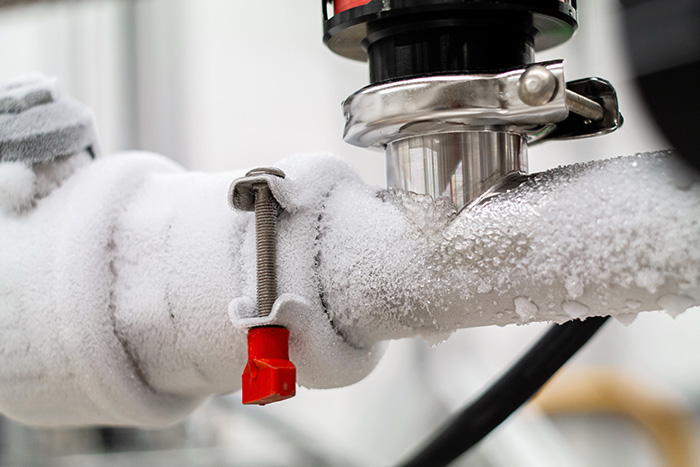Ways to Maintain Pipes from Cold Weather Damage: Essential Tips
Ways to Maintain Pipes from Cold Weather Damage: Essential Tips
Blog Article
We have discovered this article on Preventing and dealing with frozen pipes directly below on the net and felt it made good sense to discuss it with you in this article.

Winter can ruin your plumbing, especially by freezing pipelines. Below's how to prevent it from occurring and what to do if it does.
Introduction
As temperatures drop, the danger of icy pipes rises, possibly resulting in costly repair work and water damages. Understanding exactly how to prevent frozen pipes is important for home owners in cold environments.
Prevention Tips
Insulating susceptible pipelines
Wrap pipelines in insulation sleeves or use warm tape to protect them from freezing temperature levels. Focus on pipes in unheated or outside areas of the home.
Heating strategies
Keep interior areas adequately warmed, specifically areas with pipes. Open up cabinet doors to enable warm air to circulate around pipes under sinks.
Just how to recognize frozen pipelines
Try to find lowered water circulation from taps, unusual odors or sounds from pipes, and visible frost on exposed pipes.
Long-Term Solutions
Structural changes
Take into consideration rerouting pipes far from outside walls or unheated areas. Add additional insulation to attic rooms, cellars, and crawl spaces.
Updating insulation
Buy top notch insulation for pipelines, attic rooms, and wall surfaces. Correct insulation assists keep constant temperatures and reduces the threat of frozen pipes.
Shielding Outside Pipes
Yard hoses and exterior taps
Disconnect and drain pipes garden hose pipes prior to wintertime. Install frost-proof spigots or cover exterior faucets with protected caps.
Understanding Icy Pipes
What creates pipes to freeze?
Pipelines freeze when subjected to temperature levels below 32 ° F (0 ° C) for extended periods. As water inside the pipes ices up, it increases, taxing the pipe wall surfaces and potentially creating them to burst.
Threats and damages
Frozen pipelines can cause supply of water interruptions, home damages, and costly repair work. Burst pipes can flooding homes and create considerable architectural damage.
Indicators of Frozen Water Lines
Recognizing icy pipes early can stop them from rupturing.
What to Do If Your Pipes Freeze
Immediate actions to take
If you believe icy pipes, keep taps open up to ease pressure as the ice thaws. Use a hairdryer or towels taken in hot water to thaw pipelines gradually.
Final thought
Preventing icy pipelines calls for positive measures and quick feedbacks. By understanding the reasons, indicators, and preventive measures, homeowners can safeguard their plumbing during winter.
5 Ways to Prevent Frozen Pipes
Drain Outdoor Faucets and Disconnect Hoses
First, close the shut-off valve that controls the flow of water in the pipe to your outdoor faucet. Then, head outside to disconnect and drain your hose and open the outdoor faucet to allow the water to completely drain out of the line. Turn off the faucet when done. Finally, head back to the shut-off valve and drain the remaining water inside the pipe into a bucket or container. Additionally, if you have a home irrigation system, you should consider hiring an expert to clear the system of water each year.
Insulate Pipes
One of the best and most cost-effective methods for preventing frozen water pipes is to wrap your pipes with insulation. This is especially important for areas in your home that aren’t exposed to heat, such as an attic. We suggest using foam sleeves, which can typically be found at your local hardware store.
Keep Heat Running at 65
Your pipes are located inside your walls, and the temperature there is much colder than the rest of the house. To prevent your pipes from freezing, The Insurance Information Institute suggests that you keep your home heated to at least 65 degrees, even when traveling. You may want to invest in smart devices that can keep an eye on the temperature in your home while you’re away.
Leave Water Dripping
Moving water — even a small trickle — can prevent ice from forming inside your pipes. When freezing temps are imminent, start a drip of water from all faucets that serve exposed pipes. Leaving a few faucets running will also help relieve pressure inside the pipes and help prevent a rupture if the water inside freezes.
Open Cupboard Doors
Warm your kitchen and bathroom pipes by opening cupboards and vanities. You should also leave your interior doors ajar to help warm air circulate evenly throughout your home.

As an avid reader on How to Prevent Your Pipes From Freezing, I was thinking sharing that piece of content was really helpful. Sharing is nice. Helping people is fun. Many thanks for your time invested reading it.
Get An Estimate Report this page